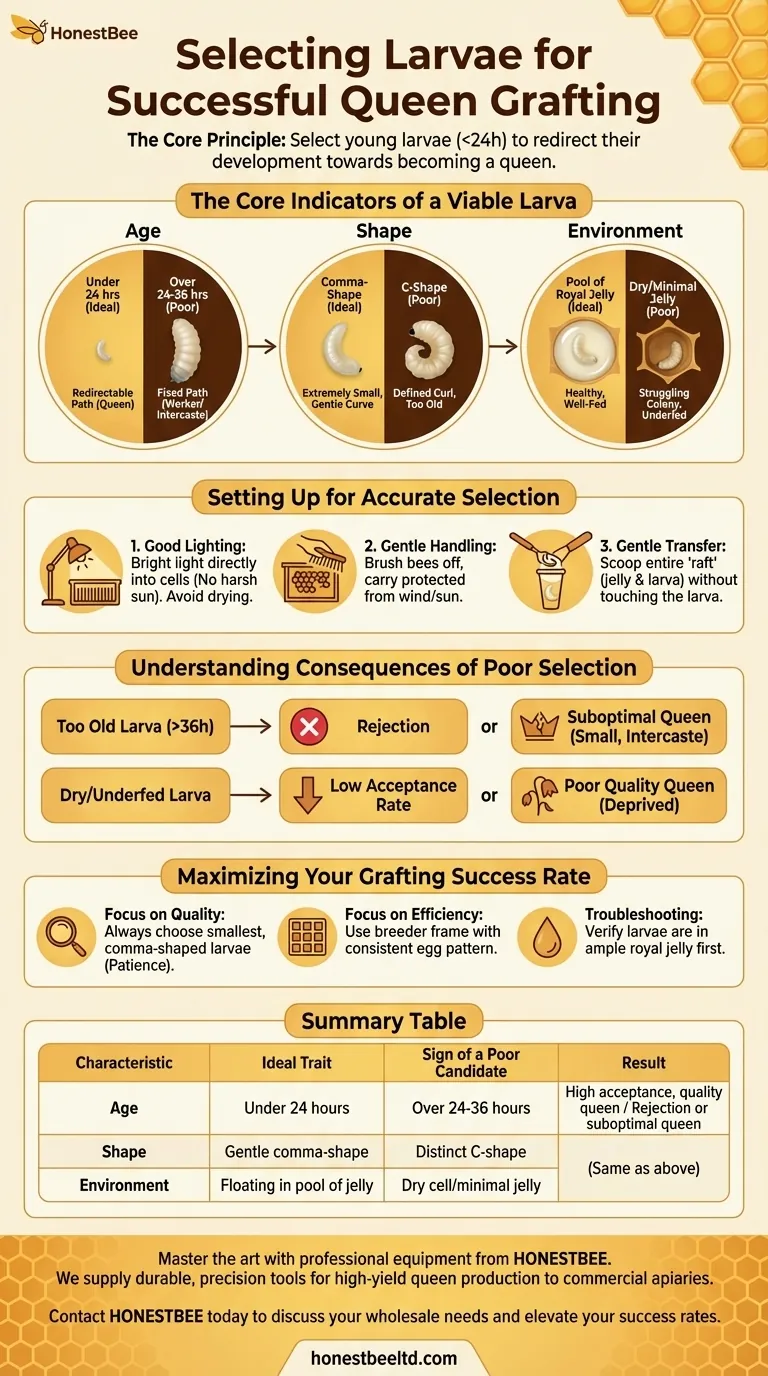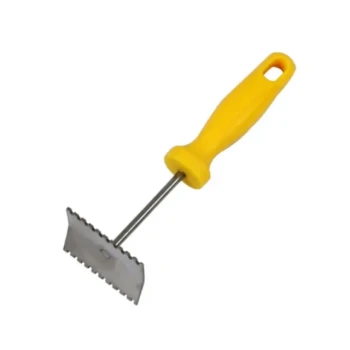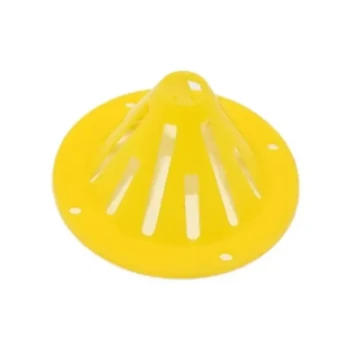To ensure a successful graft, you must select a worker larva that is less than 24 hours old, visually identified by its very small size and slight "comma" shape. Critically, this larva must be floating in a generous pool of royal jelly, which indicates it is healthy and well-fed.
The core principle of grafting is selecting a larva so young that its developmental path is not yet fixed. This allows the nurse bees in the cell-builder colony to redirect its development, feeding it an exclusive diet of royal jelly to create a queen instead of a worker.

The Core Indicators of a Viable Larva
Success in queen rearing begins with identifying the precise characteristics of a larva that is suitable for grafting. Age and environment are the two non-negotiable factors.
Age Is the Deciding Factor
The single most important trait is age. You must select larvae that are under 24 hours old from the moment they hatched from the egg.
After this brief window, the larva's developmental trajectory becomes increasingly fixed towards becoming a worker bee. Grafting an older larva will result in rejection or the creation of a poor-quality queen.
The "Comma" vs. "C" Shape
Visual identification is your primary tool for judging age.
An ideal larva is extremely small and has a gentle, comma-shaped curvature. It will appear almost like a tiny, floating speck.
As a larva ages past the ideal window, it grows rapidly and its body curls into a more defined "C" shape. If you see a distinct C-shape, the larva is too old to graft.
A Bed of Royal Jelly
The larva must be floating on what looks like a small raft or pool of milky-white royal jelly.
This indicates two things: first, the larva comes from a strong, well-fed breeder colony, and second, it provides a crucial buffer during transfer. This "raft" helps you scoop the larva without touching or injuring its delicate body.
Setting Up for Accurate Selection
You cannot assess these minute details without preparing your environment correctly. How you handle the frame is just as important as what you look for.
The Importance of Good Lighting
You need excellent, bright light that shines directly into the bottom of the cells. Avoid working in direct, harsh sunlight, which can dry out the larvae.
Position the frame so you can look down into the cells without casting a shadow, allowing you to clearly see the larva's shape and its bed of royal jelly.
Gentle Frame Handling
When you retrieve the frame from your breeder hive, gently brush all the adult bees off.
Carry the frame carefully to your grafting station, protecting it from wind and sun to prevent the delicate larvae from drying out or being chilled.
The Gentle Transfer
The goal of the grafting tool is to slide under the royal jelly and lift the larva without touching it.
By following the curve of the cell, you scoop the entire "raft"—larva and jelly—and place it gently onto the bottom of the prepared queen cup.
Understanding the Consequences of Poor Selection
Mistakes in larval selection are the most common cause of failure in queen rearing. Understanding the outcomes of a poor choice reinforces the importance of the rules.
Grafting Larvae That Are Too Old
If you graft a larva that is older than 24-36 hours, the colony will likely reject it immediately.
If they do accept it, the resulting queen will be suboptimal. She may be small or possess characteristics somewhere between a worker and a queen (an intercaste), leading to poor performance and a short lifespan.
Grafting Dry or Underfed Larvae
A larva sitting in a "dry" cell with little to no royal jelly is a sign of a struggling colony or poor nutrition.
These larvae have a much lower acceptance rate because they are less vigorous. Even if accepted, they have been deprived of nutrition at a critical stage, which can impact the final quality of the queen.
How to Maximize Your Grafting Success Rate
With practice, achieving an 80-90% acceptance rate is a realistic goal. Focus on perfecting your selection process to get there.
- If your primary focus is quality: Always choose the absolute smallest, comma-shaped larvae you can find, even if it requires more time and patience to locate them.
- If your primary focus is efficiency: Use a breeder frame where the queen laid eggs in a very consistent pattern, ensuring you have a large patch of evenly-aged larvae to choose from.
- If you are troubleshooting low acceptance rates: The first thing to verify is that your selected larvae are swimming in ample royal jelly, as this is the clearest sign of health and vitality.
Mastering this selection process is the foundational skill for consistently producing high-quality queen bees.
Summary Table:
| Key Characteristic | Ideal Trait | Sign of a Poor Candidate |
|---|---|---|
| Age | Under 24 hours old | Over 24-36 hours old |
| Shape | Gentle comma-shape | Distinct C-shape |
| Environment | Floating in a pool of royal jelly | Dry cell or minimal royal jelly |
| Result | High acceptance rate, quality queen | Rejection or suboptimal queen |
Master the art of queen rearing with the right equipment. Selecting the perfect larva is just the first step. Ensure your entire operation is set up for success with professional-grade grafting tools, queen cups, and cell-building supplies from HONESTBEE. We supply commercial apiaries and beekeeping equipment distributors with the durable, precision tools needed for high-yield queen production.
Contact HONESTBEE today to discuss your wholesale needs and elevate your queen-rearing success rates.
Visual Guide

Related Products
- Retractable Chinese Queen Rearing Grafting Tools Equipment
- Plastic Beekeeping Honey Bee Larvae Grafting Tools for Queen Rearing and Chinese Grafting
- Black 2 Pack Beekeeper Queen Grafting Tool for Bee Queen Larva Transferring Needle
- Plastic Chinese Queen Grafting Tool for Bee Queen Rearing
- Brown Nicot Queen Cell Cups for Breeding Queen Bees Beekeeping
People Also Ask
- What is the primary method beekeepers use to produce multiple queen honey bees in a season? Master Grafting for Superior Genetics
- What is the Doolittle method of queen rearing? Master Controlled Queen Production for Your Apiary
- What are the key steps in the grafting technique? Master Queen Rearing for a Thriving Apiary
- What are the steps involved in the grafting process? Master Queen Rearing for Your Apiary
- What is the process of grafting larvae? Master the Art of Queen Rearing for Your Apiary



















